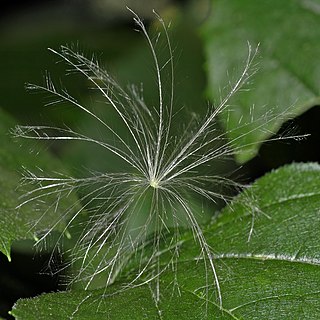
The pappus is the modified calyx, the part of an individual floret, that surrounds the base of the corolla tube in flower heads of the plant family Asteraceae. The term is sometimes used in other plant families such as Asclepiadaceae (milkweeds), whose seeds have a similar structure attached, although it is not related to the calyx of the flower.

Ageratina altissima, also known as white snakeroot, richweed, or white sanicle, is a poisonous perennial herb in the family Asteraceae, native to eastern and central North America. An older binomial name for this species is Eupatorium rugosum, but the genus Eupatorium has undergone taxonomic revision by botanists, and a number of the species that were once included in it have been moved to other genera.
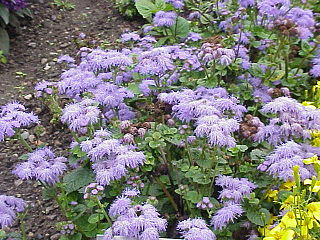
Eupatorieae is a tribe of over 2000 species of plants in the aster family. Most of the species are native to tropical, subtropical, and warm temperate areas of the Americas, but some are found elsewhere. Well-known members are Stevia rebaudiana, a number of medicinal plants (Eupatorium), and a variety of late summer to autumn blooming garden flowers, including Ageratum (flossflower), Conoclinium (mistflower), and Liatris.

Eupatorium capillifolium, or dogfennel, is a North American perennial herbaceous plant in the family sunflower family, native to the eastern and south-central United States. It is generally between 50 cm and 2 meters tall with several stems that fork from a substantial base. The stems and base are covered in leaves so dissected that they resemble branching green threads coming out of the stem in fractal patterns. When crushed, the leaves and flowers smell rather unpleasant.
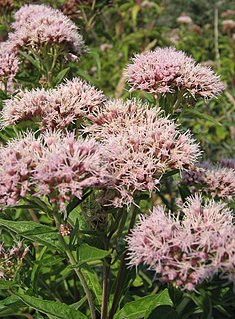
Eupatorium cannabinum, commonly known as hemp-agrimony, or holy rope, is a herbaceous plant of the daisy family. It is a robust perennial native to many areas of Europe. It is cultivated as an ornamental and occasionally found as a garden escape in scattered locations in China, the United States and Canada.
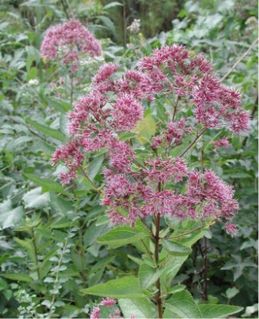
Eutrochium is a North American genus of herbaceous flowering plants in the sunflower family. They are commonly referred to as Joe-Pye weeds. They are native to the United States and Canada, and have non-dissected foliage and pigmented flowers.

Eupatorium hyssopifolium, also known as hyssopleaf thoroughwort, is a fall-blooming herbaceous plant native to North America. Like other members of the genus Eupatorium it has inflorescences containing a large number of very small flower heads, each with 5 white disc florets but no ray florets. At 0.5 to one meter tall, it is towards the shorter end of the range of heights found in Eupatorium species.

Eupatorium album, or white thoroughwort, is a herbaceous perennial plant in the sunflower family native from the eastern and southern United States, from eastern Texas to Connecticut, inland as far as Indiana.
Eupatorium leucolepis, commonly called justiceweed or white-bracted thoroughwort, is a herbaceous perennial plant in Asteraceae native from the eastern coastal United States, from New York to eastern Texas, with scattered populations inland as far as Kentucky and West Virginia.

Eupatorium mohrii, commonly called Mohr's thoroughwort, is a herbaceous perennial plant in Asteraceae native to the southeastern and south-central states of the United States, in the coastal plain from Virginia to Texas. It has also been found in the Dominican Republic.

Eupatorium resinosum, or pine barren thoroughwort, is a rare North American plant species in the sunflower family.
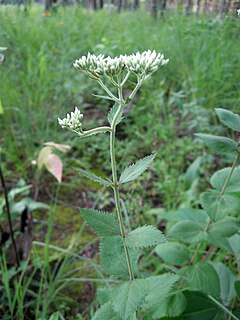
Eupatorium rotundifolium, commonly called roundleaf thoroughwort, is a North American species of plant in sunflower family. It native to the eastern and central United States, in all the coastal states from Maine to Texas, and inland as far as Missouri and the Ohio Valley. It is found in low, moist habitats such as wet savannas and bogs.
Eupatorium semiserratum, commonly called smallflower thoroughwort, is a North American plant species in the sunflower family. It is native to the southeastern and south-central United States, found in all the coastal states from Maryland to Texas and inland as far as Missouri and Kentucky.

Udea ferrugalis, the rusty dot pearl, is a species of moth of the family Crambidae. The species was first described by Jacob Hübner in 1796.

Oidaematophorus eupatorii, the eupatorium plume moth or Joe Pye plume moth, is a moth of the family Pterophoridae. It is found in North America, including Florida, Mississippi, Iowa, New York, California and Vancouver Island. It is also known from Mexico, Guatemala and Panama.

Gnophos furvata is a species of moth in the family Geometridae. It is found in southern and central Europe. In the east, the range extends to the Carpathian Mountains and Ukraine.
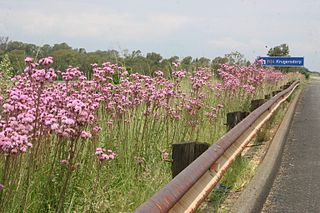
Eupatorium macrocephalum Less. aka pompom weed, is a cosmopolitan perennial plant belonging to the family of Asteraceae and regarded as an invasive weed in some countries. It is native to the southern United States, Central America, South America and was introduced to South Africa. It is classed as a principal weed in Brazil. In South Africa it has been cultivated as an ornamental, is often found on roadsides, and has become of concern for its invading of undisturbed climax grassland and wetlands since the 1960s. It is closely related to Siam weed, and is one of some 268 species in the genus.
Eupatorium novae-angliae, commonly called New England boneset, New England justiceweed or New England thoroughwort, is a rare and endangered North American species in the sunflower family. It is found only in 4 counties in southern New England. The species is listed as endangered species in both states.

















